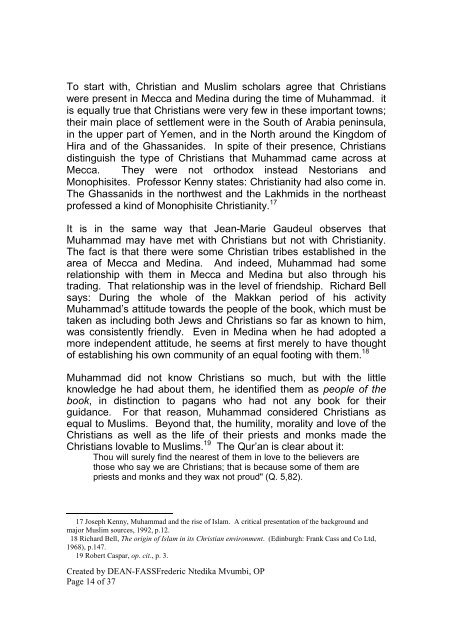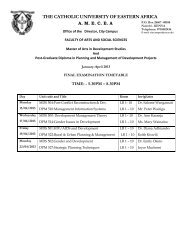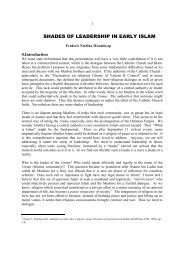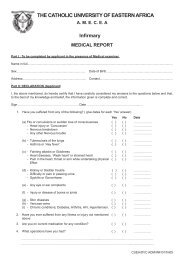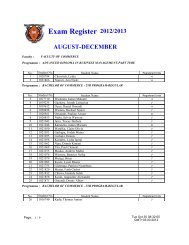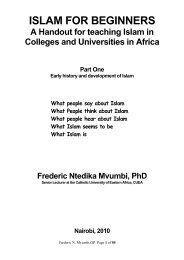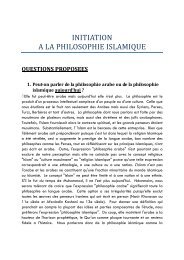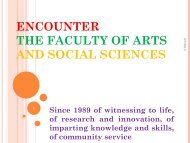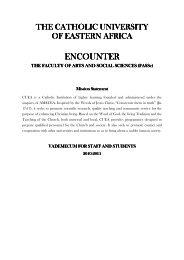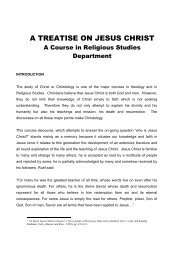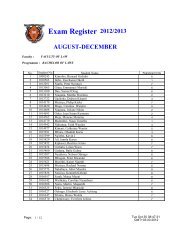PRINCIPLES FOR INTERRELIGIOUS DIALOGUE.pdf - CUEA
PRINCIPLES FOR INTERRELIGIOUS DIALOGUE.pdf - CUEA
PRINCIPLES FOR INTERRELIGIOUS DIALOGUE.pdf - CUEA
Create successful ePaper yourself
Turn your PDF publications into a flip-book with our unique Google optimized e-Paper software.
To start with, Christian and Muslim scholars agree that Christians<br />
were present in Mecca and Medina during the time of Muhammad. it<br />
is equally true that Christians were very few in these important towns;<br />
their main place of settlement were in the South of Arabia peninsula,<br />
in the upper part of Yemen, and in the North around the Kingdom of<br />
Hira and of the Ghassanides. In spite of their presence, Christians<br />
distinguish the type of Christians that Muhammad came across at<br />
Mecca. They were not orthodox instead Nestorians and<br />
Monophisites. Professor Kenny states: Christianity had also come in.<br />
The Ghassanids in the northwest and the Lakhmids in the northeast<br />
professed a kind of Monophisite Christianity. 17<br />
It is in the same way that Jean-Marie Gaudeul observes that<br />
Muhammad may have met with Christians but not with Christianity.<br />
The fact is that there were some Christian tribes established in the<br />
area of Mecca and Medina. And indeed, Muhammad had some<br />
relationship with them in Mecca and Medina but also through his<br />
trading. That relationship was in the level of friendship. Richard Bell<br />
says: During the whole of the Makkan period of his activity<br />
Muhammad’s attitude towards the people of the book, which must be<br />
taken as including both Jews and Christians so far as known to him,<br />
was consistently friendly. Even in Medina when he had adopted a<br />
more independent attitude, he seems at first merely to have thought<br />
of establishing his own community of an equal footing with them. 18<br />
Muhammad did not know Christians so much, but with the little<br />
knowledge he had about them, he identified them as people of the<br />
book, in distinction to pagans who had not any book for their<br />
guidance. For that reason, Muhammad considered Christians as<br />
equal to Muslims. Beyond that, the humility, morality and love of the<br />
Christians as well as the life of their priests and monks made the<br />
Christians lovable to Muslims. 19 The Qur’an is clear about it:<br />
Thou will surely find the nearest of them in love to the believers are<br />
those who say we are Christians; that is because some of them are<br />
priests and monks and they wax not proud" (Q. 5,82).<br />
17 Joseph Kenny, Muhammad and the rise of Islam. A critical presentation of the background and<br />
major Muslim sources, 1992, p.12.<br />
18 Richard Bell, The origin of Islam in its Christian environment. (Edinburgh: Frank Cass and Co Ltd,<br />
1968), p.147.<br />
19 Robert Caspar, op. cit., p. 3.<br />
Created by DEAN-FASSFrederic Ntedika Mvumbi, OP<br />
Page 14 of 37


